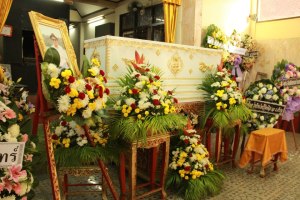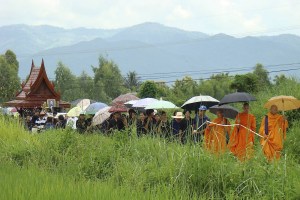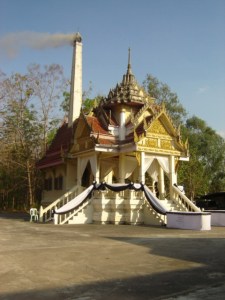The eighty-four year old mother of one of the secretaries at school recently died.
As Khun Noi – the secretary – was almost the first person I met when I joined Prem School and as she was then and continues to be a very helpful and caring colleague, I felt I should attend the funeral or some part of it, and decided to go to the cremation rather than the funeral service the previous night. (“Khun”, by the way, is a very useful Thai word meaning Mr or Mrs or Miss, or in certain circumstances, such as when the waiter in the restaurant sees everyone but you, Hey you there!) I had sent a letter of condolence, and a thousand baht note as I had been told it was usual to make a monetary gift. I do not know if THB 1000 (AU$30.00) was a generous or a mean token. It is about a week’s wages for one of the school’s many gardeners – but quite a lot less for administrative staff.
When I get dressed in the morning – no – wait! It is relevant, I assure you.
Although it would be easy and very cheap to have my housekeeper or someone else in my village do my washing and ironing, I do it myself, and the order of shirts in the wardrobe is purely random: red followed by white followed by black followed by yellow, according to the order they get plucked from the ironing heap. On the day of the cremation the next shirt on the rack was a black one and I put it on, not particularly thinking about suitability of the colour for a funeral, as in Australia the tradition of wearing black to funerals has just about died out – if you’ll forgive the ill-advised pun.
A Thai colleague drew me a map so I could find Khun Noi’s house. She also said that I could just follow the arrows on the road – but I thought she was joking. I found the temple near Khun Noi’s house easily enough … and there were indeed arrows on pieces of paper and spray-painted on the road, and signs saying (I guess) THIS WAY TO THE FUNERAL HOUSE on every street sign and light pole.
As I arrived at the house, it and the yard were packed with people sitting, chatting, eating sunflower seeds and drinking bottles of water. Everyone was in black from top to toe, except for one woman who was solidly white, so I was very pleased my random wardrobe selection had not seen me going off to school and then to the cremation in a brightly coloured shirt.
I asked my Thai colleague, the next day, what people would have thought had I not been dressed in black. She said that people would simply have thought I was an ignorant foreigner who did not know that not to wear black – or white – was a significant insult to the mourners since it did not show respect for the dead. I wonder, if I had been in a rainbow-striped shirt and emerald green trousers and red shoes, if she would have told me to go home and to get changed before going to the cremation…?
There was quite a lot of sitting. And then some more. I was the only non-Thai present and was rather embarrassed when the family kept asking if I would like some lunch … or an ice cream … or something to drink … when none of the other mourners seemed to be lunching or nibbling on icy poles. What I really wanted was to go to the lavatory – my 60-something bladder was complaining about all the sitting
Khun Noi’s mum’s coffin – an elaborate white and gold affair – was the centrepiece of a gold and white “palace” made of timber, paper and gold foil. Incense, offerings to monks, photographs of the dead woman and bunches of flowers were heaped on the steps of the “palace”, which in turn was situated on a low trolley. Three or four huge funeral wreaths were displayed on massive stands near the coffin. People did not seem to be paying too much attention to the coffin – no quiet nods or bows as people passed it, no reverential praying – or even any basic acknowledgement that it was there. It was a bit like the elephant in the sitting room.
There was also a large and locked box on a table. Occasionally people would put folded envelopes – presumably containing cash – into the box, so I guess my letter and donation had somehow found their way into it as well. Khun Noi told me that the family was going to the local wat to be blessed and that we would then go to the cremation. After a bit more sitting I strolled down to the wat to watch what was happening.
More sitting about. People were chatting with each other, smoking or talking on their mobile phones. Those inside the temple area were a bit quieter. Eventually a chubby monk turned up, went inside, chanted a prayer or two, then having done his bit left again to go back to whatever he had been doing before-hand. Judging by the size of him it was perhaps inhaling double cheeseburgers. I have yet to learn the absolute respect that seems to be demanded by – and given to – monks in this country. Perhaps that will come when I master the five tones of spoken Thai that differentiate “ma” = horse, “ma” = dog, “ma” = to come, and other similar words meaning new straw or mother … “Mother” or “Ma” in English is “mae” in Thai and pronounced “mare” – the same pronunciation as the English word for a female horse. “Horse” in Thai is, as we have learned – are you paying attention at the back, there? –is “ma”, so by a simple quadratic or other equation, “Mother” = “Ma” = “mare” = horse = “ma”. QED. Quite simple really: Mum’s an old nag!
One can get into serious trouble here riding your horse or your dog … or throwing stones at stray dogs or the old lady.
A blessing by the monks
Back at the funeral, a layman then led a series of chanted prayers and the blessing of buckets of monks’ offerings. A chrysanthemum dipped into what seemed to be a glass of Lapsang Souchong tea was used to sprinkle holy water – or holy tea – over the monks’ offerings.
A bit more coming and going and sitting and kneeling, then the chubby monk plus five or six other monks and six or seven young monks (monkies? monkeys?) all suddenly appeared, filed in to their seats or pieces of carpet on the floor depending on their rank or girth. Some more chanting. And sitting. Finally the buckets of monks’ goods (new robes, candles, incense, matches, soap powder) were presented by family members. If the presenter was a woman, the monk merely acknowledge the gift by touching it – not the woman – with the edge of his robe.
Then back to the house. No more sitting about. I had asked how the coffin would get to the cremation place and had been told that it was pulled. I thought that the trolley would be hitched up to a car but when we got back to the house I found that long ropes had been attached to the trolley and laid out on the road. We all took hold of the ropes, a man stood on the trolley like a tram conductor, steering it with a little steering wheel I had not previously noticed, and off we set, dragging the whole shebang behind us.
Most Thai streets have masses of overhead cables – power cables and telephone cables – hanging in clumps and clusters and sometimes drooping down to the ground. The trolley + coffin + “palace” were about four metres high, so two men jogged alongside, using long bamboo poles to hoist the power and telephone cables out of the way. To help further, the top metre or so of the “palace” was spring-loaded and on hinges, with a little piece of string so that one of the attendants could lower the spire to get under cables, then allow it to pop up again, a bit like the nose cone of the Concorde in days gone by. The image at left shows the same sort of “castle” with the very tip drawn down during the road journey.
Leading the procession was a man pushing a trolley with a portrait of Khun Noi’s mum, followed by another with a banner giving her birth and death dates. Then came six or eight monks holding a white rope that was then looped around the lead ends of the main ropes. Neighbours who had not been to the house or at the wat came out of their houses as the procession wobbled its way along, joined in and seized the ropes to become part of the event. Some neighbours walked just a short way, others stayed for the whole walk to the crematorium. Umbrellas were offered to shade some of the women from the sun – others simply held their handbags up to block the sun’s rays.
The procession had to cross a major four-lane highway.
A couple of people simply stood in the road with their hands up to stop the traffic and we all slowly trooped across the road while scores of cars on either side of the highway waited for the procession to cross. People in shops or eating places along the way either ignored us all, or called out friendly greetings to those tugging on the ropes.
At the crematorium the coffin and trolley had a minor collision with a tree but was finally manoeuvred in front of the sala where the monks sat – those who had helped pull the coffin and many others who had been driven down in the back of pick-up trucks. On the other side of the ground sat many rows of black-clad mourners sipping on iced drinks handed out by people from Prem. I do not know if that is a usual custom or one put on by the school. Also handed out were small jars of ointment – rather smelly stuff like Tiger Balm ointment and wonderful for clearing blocked nostrils – as a keepsake – and small wooden flowers with about an inch of candle taped to them.
Various people from the crowd were called on to present new robes and money to the monks – all supplied by the family – so I guess those donations came in handy. The monks accepted the robes and the glasses of water offered by keeping the robes and by pouring the glasses of water on the ground. I am sure there is religious or funerary or even dietary significance in the latter.
Eventually we all placed the wooden flowers / candles back in baskets so they could be burned along with the body. At a silent and mysterious signal, everyone from the far left of the guests’ sala started moving to the coffin. Men usually go first, followed by the women, but on this day it was a sort of co-ed affair, with people “wai”ing (hands clasped in front of the nose and accompanied by a deep bow) Khun Noi and her sister and a mysterious man (possibly a brother), and carefully placing the flowers in the basket.
The trolley was then pushed, shoved and tugged closer to the funeral pyre: a matching pair of concrete steps either side of a fire pit filled with old car tyres and bits of broken wood.
Khun Noi’s mum’s coffin was pretty unceremoniously dragged out of the “palace” and taken behind a low concrete block wall. Quite a few people went to watch what was going on. The coffin was opened and the dead woman’s face and the coffin itself were washed with coconut milk to help purify her for her next life. While this was happening, the photographs and flowers from the palace were placed on the steps beside the pyre, and the palace was knocked over on its side, holes unceremoniously punched in the walls, and sundry pyrotechnics were added to its structure to help it all burn and to go off, I guess, with the final big bang.
Fireworks and the big bang theory
The coffin was then brought back and put on top of the pyre and the palace loaded on top. A wire was attached to the palace and to the monks’ sala and a rocket device attached to the wire. At another silent and mysterious signal, the rocket was ignited … Showers of fire sprouted from its rear end … and it zoomed from the monks’ sala to the funeral pyre and smacked into the palace.
And nothing happened.
I think I had been expecting a huge bang and sheets of fire but everything just sort of sat there for several seconds as we watched, sipping on our iced orange juices and holding our tubs of Tiger Balm ointment.
Finally sparks reached gunpowder … and the string of fireworks around the top of the palace blasted off with whizzes and bangs, and the huge firecrackers in the basement went off and the whole affair was gaily ablaze. A chap helped it all with a few bottles of petrol or kerosene that he poured over the palace and the temple.
And everyone went home.
I walked back to my little red car and headed back to school, driving for a while behind a pick-up truck with a new “palace” aboard, getting ready for another send off. Dark clouds of black smoke were rising from the cremation site – those car tyres! – and I learned later that the family would return to the pyre a day or so later to collect any unburned bones, which would either be set as talismans and worn as pendants around family members’ necks, or cast into the local Mae Ping River.
Although it does not quite follow the various traditions I have mentioned, the following YouTube video will perhaps give you an idea of this rather splendid – and quite unemotional and quite practical – send off: www. youtube.com/watch?v=Zhs4_Qh83lc
Khun Noi’s mother’s send-off was a fine ceremony, where the focus was on giving to the monks and to the community, and where the officials seemed to take a back seat and let the people perform most of the rituals. No elaborate orders of service were printed. The whole village was able to participate at whatever level they wished, and the family, while grieving, also seemed to celebrate a death that was part of a greater cycle.
Leonardo da Vinci said, “As a well-spent day brings happy sleep, so a life well-used brings happy death.”
I think the Thais have just about got it right.
……………
- Funeral took place 2011
- Text © Christopher Hall 2014
- All photographs downloaded from the Internet. Please contact me if any photograph breaches copyright rules and it will be removed from this blog
- If you enjoyed this story please forward the blog address to your friends: www.hallomega.com
- If you would like to receive automatic notification of future postings on this blog please click on the FOLLOW button
……………



This reminds me of the first cremation I attended with my western eyes trying to make sense of what was going on around me! Your account had me smiling as I remembered my experiences and recalled my thoughts at the time.
LikeLike
Thanks Lynda
Every day in Thailand is a new experience! I have just come home after a day by a pool in San Kam Paeng district, and a quick glass of wine at a bar in “my village” of Chiang Khien, with people on foot, on bicycles, on motorbikes … and an occasional car .. passing by
Lovely!
Cheers
Chris
LikeLike